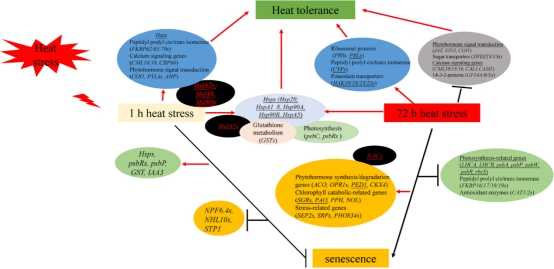Name:Liang Chen
Tell:
Email:chenliang888@wbgcas.cn
Organization:Wuhan Botanical Garden
Research Elucidates Mechanism of Heat Stress Response and Heat-accelerated Leaf Senescence in Tall Fescue
2020-11-02
Tall fescue (Festuca arundinacea) is one of the most important and widely used cool-season turfgrass and forage species all over the world. The optimum temperature for tall fescue growth ranges from 15 to 25 °C. The high temperature will affect its growth and development. One of the major symptoms of heat damage is premature leaf senescence.
The Molecular Breeding of Turfgrass and Forage Grass Group led by Prof. CHEN Liang from Wuhan Botanical Garden reported the molecular mechanism of heat adaptation and heat-induced senescence at transcriptional and post-transcriptional levels in tall fescue.
Researchers compared the transcriptome files of heat-treated (1 h and 72 h) and senescent leaves of tall fescue by combining single-molecular real-time and Illumina sequencing.
Results found that short-term heat stress (HS) may improve thermotolerance by strongly activating heat shock proteins (Hsps) and heat shock factors (Hsfs), as well as specifically activating FK506-binding proteins (FKBPs), calcium signaling genes, glutathione S-transferase genes, photosynthesis-related genes, and phytohormone signaling genes. But in comparison, long-term HS may lead to leaf senescence via activating chlorophyll catabolic genes, phytohormone synthesis/degradation genes, stress-related genes, and NACs, and repressing photosynthesis-related genes, FKBPs, and catalases.
Subsequently, the roles of three candidate genes, including FaHsfA2a, FaNAC029, and FaNAM-B1 in heat stress response were investigated via transient overexpression in tobacco. Besides, they discovered that alternative splicing occurred widely in HS and senescence responsive genes.
This research helps elucidate the underlying mechanism of HSR and heat-accelerated leaf senescence in tall fescue, and can provide important clues for in-depth characterization of heat-resistance breeding candidate genes in tall fescue.
This work was supported by grants from the National Natural Science Foundation of China, the Major Science and Technology Innovation Project of Shandong Province, Poverty Alleviation through Agricultural Projects from the Agricultural Office of Chinese Academy of Sciences, and the Strategic Priority Research Program of the Chinese Academy of Sciences.
Results have been published on BMC Plant Biology entitled “SMRT and Illumina RNA sequencing reveal novel insights into the heat stress response and crosstalk with leaf senescence in tall fescue”.

A hypothetical model of heat stress response and the crosstalk between heat stress and leaf senescence in tall fescue. Underlines represent that the differentially expressed isoforms were produced by AS (Image by WBG)